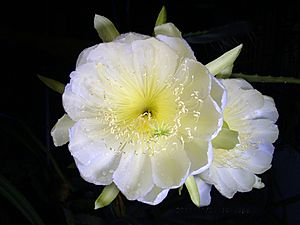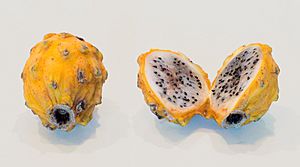Yellow pitahaya facts for kids
Quick facts for kids Yellow pitahaya |
|
|---|---|
 |
|
 |
|
| Conservation status | |
| Scientific classification | |
| Genus: |
Selenicereus
|
| Species: |
megalanthus
|
| Synonyms | |
|
|
The Selenicereus megalanthus is a type of cactus that grows in northern South America. It is also known as the Hylocereus megalanthus. People often call its fruit "pitahaya" or "yellow dragon fruit."
This plant is grown to sell its tasty yellow fruit. It's also a beautiful climbing plant with some of the biggest flowers in the cactus family! Unlike the red dragon fruits, the yellow ones have small thorns on their skin. You might hear it called "yellow pitahaya," "kirin fruit," or "yellow pitaya."
Contents
What's in a Name?
The word "megalanthus" comes from Greek. It means "large flowered." This cactus truly lives up to its name, as it produces some of the biggest flowers among all cacti!
Where Does It Grow?
This special cactus comes from countries like Colombia, Costa Rica, Ecuador, Nicaragua, Panama, Peru, Trinidad and Tobago, and Venezuela.
You can find it growing in tropical forests near rivers. It often grows on other plants or trees, which is called being an epiphyte. Sometimes, it can also grow in dry places, like a xerophyte.
What Does It Look Like?
- Stems: The stems can lie on the ground, climb up things, or hang down. They are usually thin, about 1.5 cm (0.6 inches) thick. They often grow roots in the air.
- Ribs: Each stem has three ribs, which are like ridges. The edges of these ribs are a bit wavy.
- Spines: You'll find small, yellowish spines, about 2-3 mm long. There are usually 1 to 3 spines in each spot. Young parts of the plant might have some brittle hairs.
- Skin: The skin of the stem is green.
- Flowers: The flowers are amazing! They are shaped like a funnel and open only at night. They are very large, about 32–38 cm (12.5–15 inches) long.
- The outer petals are long and green.
- The inner petals are white and about 10 cm (4 inches) long.
- The flowers have many yellow parts called stamens.
- Fruit: The fruit is oval-shaped and has small bumps and spines. Its skin is usually yellow, but sometimes it can be red or orange if it's a mix of different types.
- Inside, the fruit is white, but it can be pink if it's a hybrid.
- It has small black seeds.
- The fruit is edible and tastes pleasantly sweet and mild.
- Pollination: Yellow pitayas are "self-fertile." This means they can make fruit on their own without needing pollen from another plant.
How to Grow This Plant
This cactus is quite easy to grow and grows quickly!
- Soil: It likes soil that has a lot of humus, which is rich, dark soil from decayed plants.
- Water: It needs enough water during the summer months.
- Temperature: In winter, it's important to keep it warm. It shouldn't be in temperatures below 8°C (46.5°F).
- Sunlight: While it can grow in partial shade, it grows best in full sunlight. Giving it extra light in early spring can help it grow flower buds.
- Flowering Time: This plant usually flowers from June to October.
- Size: Be aware that this plant can grow to be very large!
Australian Gold Variety
There's a special type called 'Australian Gold'. This variety produces the biggest yellow dragon fruit in the world that doesn't have thorns!
- Fruit: The fruit has white flesh and tastes sweet, a bit like a kiwi fruit.
- Branches: Its branches are thick and dark green. They can handle very hot or very cold weather well.
- Self-sterile: 'Australian Gold' is "self-sterile," meaning it needs pollen from another plant to make fruit.
- Fruit Weight: Its fruits usually weigh between 0.75–1.5 lb (340–680 g).
See also
 In Spanish: Hylocereus megalanthus para niños
In Spanish: Hylocereus megalanthus para niños


